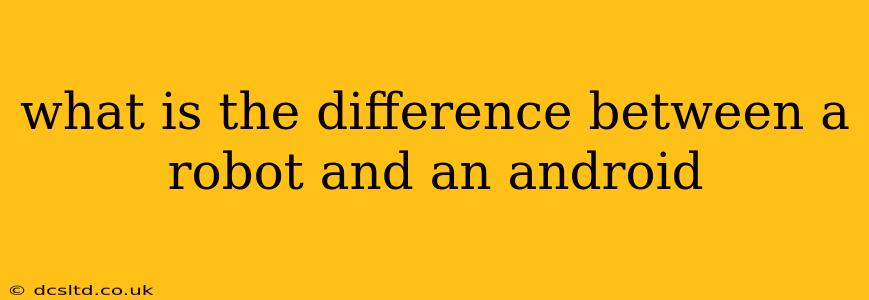What's the Difference Between a Robot and an Android?
The terms "robot" and "android" are often used interchangeably in popular culture, leading to confusion. However, there's a key distinction between the two, although the lines can blur depending on the context. Understanding this difference hinges on understanding their fundamental design and purpose.
Robot: A robot is a programmable machine designed to perform specific tasks automatically. This definition is broad and encompasses a vast array of machines, from the simple automated arm in a factory to complex, autonomous vehicles. The key characteristics of a robot are:
- Functionality: Primarily focused on performing tasks, often repetitive or dangerous for humans.
- Appearance: Robots can take many forms. They may be boxy, humanoid, animal-like, or even entirely abstract in design. Appearance is secondary to functionality.
- Intelligence: The level of intelligence varies greatly. Some robots are simple, pre-programmed machines, while others are sophisticated enough to learn and adapt to changing environments.
Android: An android, in contrast, is a specific type of robot. It's a robot designed to mimic the appearance and, to some extent, the behavior of a human. The key distinctions of an android are:
- Humanoid Appearance: The defining characteristic is its human-like form. This includes a body with a head, torso, arms, and legs.
- Mimicry of Human Behavior: While not always the case, androids often aim to imitate human movement, speech, and even expressions. This is where the line between science fiction and reality can get blurred.
- Functionality: Functionality can vary greatly. Some androids are purely for display or entertainment, while others are being developed for more practical applications, such as companionship or healthcare assistance.
Frequently Asked Questions (Addressing PAA Queries)
1. What is the main difference between a robot and an android?
The main difference is appearance and the intended mimicry of humans. A robot is a general term for a programmable machine designed for automated tasks, regardless of its appearance. An android, however, is specifically designed to resemble a human in appearance and often in behavior.
2. Are all androids robots?
Yes, all androids are robots. However, not all robots are androids. An android is a subset of the larger category of robots.
3. Can robots feel emotions?
Current robots, including androids, do not experience emotions in the same way humans do. They can be programmed to simulate emotions through facial expressions and speech, but this is a programmed response, not genuine feeling. The development of robots capable of true emotional experience is a complex and far-reaching field of research.
4. What are some examples of robots and androids?
Robots: Industrial robots on assembly lines, robotic vacuum cleaners (like Roomba), self-driving cars, surgical robots (like the da Vinci Surgical System).
Androids: While truly advanced androids are still largely in development, examples include the Sophia robot and various other humanoid robots created for research or entertainment purposes.
5. What is the future of androids?
The future of androids is exciting and uncertain. Research is constantly pushing the boundaries of their capabilities, potentially leading to androids that can provide companionship for the elderly, assist with healthcare, perform complex tasks in dangerous environments, or even contribute to space exploration. However, ethical considerations surrounding artificial intelligence and the potential social impact of advanced androids must also be carefully considered.
In conclusion, while both robots and androids are machines designed to perform tasks, androids are distinguished by their human-like appearance and their attempts to mimic human behavior. The field of robotics continues to evolve rapidly, blurring the lines between fiction and reality, and further defining the capabilities and implications of both robots and androids.
